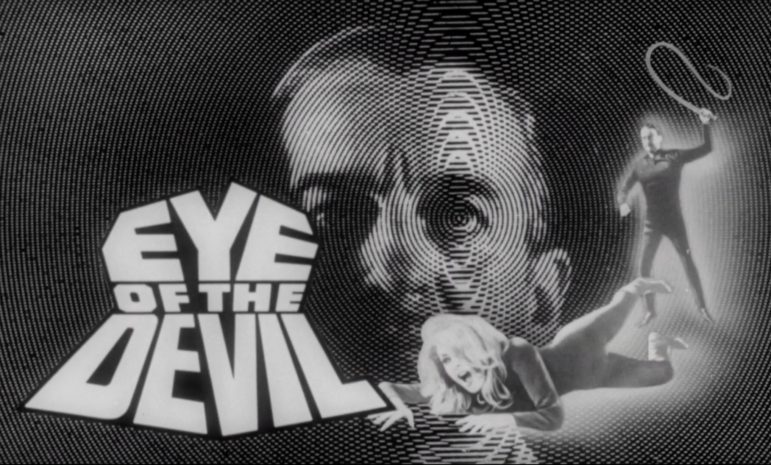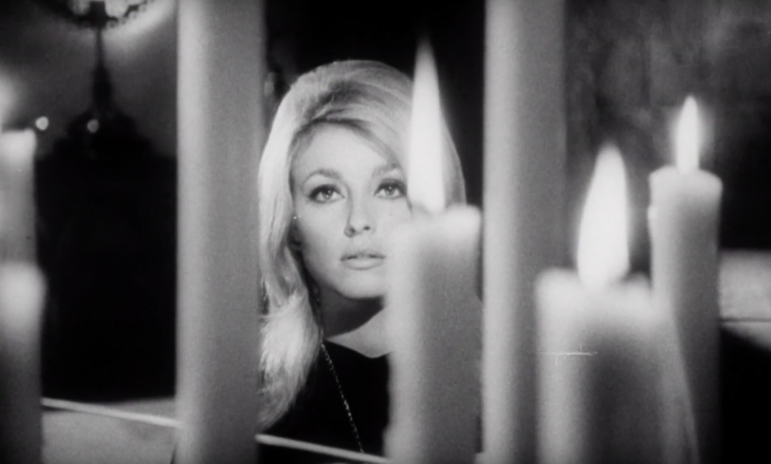
Classics of Pagan Cinema is a new occasional series in our Arts and Culture section where we explore the films that continue to resonate in the Pagan imagination year after year. Do you have a classic film with Pagan themes you would like to review for the series? Send a pitch to eric@wildhunt.org.
Today’s offering comes to us from Meg Elison. Meg Elison is a Philip K. Dick and Locus award winning author, as well as a Hugo, Nebula, Sturgeon, and Otherwise awards finalist. A prolific short story writer and essayist, Elison has been published in Slate, McSweeney’s, Fantasy & Science Fiction, Fangoria, Uncanny, Lightspeed, Nightmare, and Best American Science Fiction and Fantasy. Elison is a high school dropout and a graduate of UC Berkeley. Readers can find her on Twitter at @megelison.
“Am I seeking? Or am I being sought?”
This is the question asked by Philippe de Montfaucon, Marquis de Bellenac, played by David Niven in the halcyon days of his middle-aged handsomeness, in J. Lee Thompson’s 1966 British horror film Eye of the Devil.
An ethereal harp plays as Philippe pulls his son Jacques into his lap. They are surrounded by a party of well-dressed people in a luxe Paris living room, appointed in the style of the French empire period (and the gaudy maximalism of MGM in the 1960s). While the music plays, the marquis learns that his vineyards are failing, and he must return to his ancestral home at Bellenac. His wife Catherine (Deborah Kerr, substituting for Kim Novak, who was injured on set) decides that she and the children should follow him after a sleepwalking Jacques tells her that his father needs him.

A still from the trailer to EYE OF THE DEVIL (1966), depicting Phillipe [David Niven] whipping Odile [Sharon Tate] [MGM]
Based on the novel Day of the Arrow, published in 1964 by British author and screenwriter Robin Estridge under the name Philip Loraine, Eye of the Devil is a classic piece of Pagan cinema that draws comparisons to that other favorite of the folk-horror genre, The Wicker Man (1973). The two films share similar themes: the mystical link between the land and its ruler, the folkish ways of a remote and barely-Christianized European people, and human sacrifice. Despite it being the less popular of the two by far, Eye of the Devil delivers in some ways that The Wicker Man does not.
“The diabolical secret of the place,” as it is called by family friend Jean-Claude (Edward Mulhare), is concentrated in a magical talisman: the titular Eye of the Devil. This crystal sphere, mounted in a faux-neolithic pendant, is worn by various figures throughout the film, but especially Odile DeCaray (Sharon Tate).
Jean-Claude helpfully serves up the rest of the exposition: all the marquises before have died under mysterious circumstances. Catherine sees symbols of doom at Bellenac: a dove impaled by an arrow and served to hooded figures in a silent ritual in the chateau, a mysterious grave in the woods. Catherine finds herself surrounded by these same figures during an ill-starred trip to that same tomb.
One of the most notable elements of the film is the inclusion of Tate, an actress and model who would just a few years later be stabbed to death by members of the Manson Family cult. Tate is soft-spoken and hypnotic throughout, shot in a way that renders her beauty a spectacle even as it frames her as an aspect of the occult danger of Bellenac. She is the young woman in contrast to Kerr’s older, and while she is not expressly positioned as a rival the subtext is present. In one discordant scene, Philippe beats Odile with a tawse as she writhes on the stones and flashes defiant eyes up at him. The whipping is intended as a punishment, but Philippe seems driven by anything other than justice, and Odile seems chastened not at all.

A still of Sharon Tate as Odile in EYE OF THE DEVIL (1966) [MGM]
Catherine looks down upon the town from her window to see people celebrating Les Treize Jours—their festival of thirteen days. These are simple country folk, her doctor assures her, and this is just their simple country fair. But this fair has the same look of many that modern Pagans across Europe hold in special esteem because they emanate from folk traditions rather than from the churches where many of these processionals and observances typically terminate.
Catherine discovers her husband in the church, receiving a blessing in Latin from the parish priest. But the trappings of the church are medieval, dark and stone-carved, with visual emphasis on figures veiled in shadow and only token crucifixes visible anywhere. The implication is clear: the religion practiced here is not strictly Christian in nature. The rituals of Bellenac are syncretic – Catholic in appearance but pagan in disposition.
This ritual is later revealed to be a Black Mass, but no explicit invocation takes place. Though the film’s title names the devil, and the eye motif of the nameless talisman is repeated across the visuals of the film, Satan is never called in by any of his epithets. It is easy for a Pagan viewer to read this as the Christian tendency to refer to any other gods but their own as devil or demon; no allegiance or offering to Lucifer is ever made in the film.
The marquise intones before the crowd assembled outside the mass, “Let the earth bring forth vines yielding fruit after its kind whose seed is in itself upon the earth,” echoing Aleister Crowley’s Liber XV, the gnostic mass: “by seed and root and stem and bud and leaf and flower and fruit do we invoke thee.” Both texts have a typically cyclical Pagan flavor, making the microcosm of simple plant life into a metaphor of the entire circle of life.
20th century occultist and Witch Alex Sanders served as a consultant on the film, and his influence can be felt in these moments when dialogue takes on a midcentury Wiccan accent. As Philippe gives this prayer, he holds his son Jacques in his arms. The parallel is clear: the boy is the fruit of the man, their seed is upon the earth.
The climax of the film reveals that Philippe is a sacred king, and his fate is inextricably tied to the land over which is he lord. Philippe’s father, Alain (Emlyn Williams), has declined to die for the good of the land, which is why the vineyard is failing. Alain is white-bearded elder, long past his prime. Alain explains the image of the dancers depicted on the mysterious tomb Catherine found: the twelve dancers are like apostles surrounding the thirteenth elevated dancer, who is like Christ.
The symbolism is clear to anyone who has read The Golden Bough or a thousand texts like it that frame Christ as just another grain god who is cut down in his season so that the life eternal may be granted to all: the earth has to have a sacrifice: there will be blood.
Philippe goes to his fate with his head held high, sanctified and divine. He has been sought, and now he is ready to seek his destiny.
Eye of the Devil offers a very different lens on sacrifice than its spiritual cousin, The Wicker Man. Philippe is a willing sacrifice, giving himself up for the good of the land and the people in a Christlike gesture. Sgt. Howie is sacrificed unwilling, and even he points out that the sacrifice more likely to succeed in appeasing the gods is that of the sacred king: Lord Summerisle himself. This is the deep mystery that underpins the relationship between the land and the nobles who don’t work it: if things don’t go well, they owe the land and the people their lives.
Moreover, Eye of the Devil answers a crucial question where The Wicker Man does not. Pagan author Raven Kaldera writes in his essay on The Wicker Man that he is left unsatisfied by the ending of the film. “When I force myself to watch the violent ending, some part of me whispers the big question, the real question that is not answered in the film, that echoes silently through the mind of everyone who watches it: Did it work? Did Sergeant Howie’s death bring back the fertility of their fields? It’s easy to see what it means if it didn’t… what does it mean if it did?”
Kaldera is right: The Wicker Man is missing a scene. Either the ships leaving Summerisle are laden heavy with apples after the people gleefully kill a police officer to guarantee their harvest… or the blight continues. And decisions must be made.
When Eye of the Devil begins, the vineyard is withered for want of rain. In her witchy and soporific voice, Odile tells the noble family of Bellenac that the rain they see coming will not last, because “those are not life-giving clouds.” She’s proven right.
But after Philippe de Montfaucon, Marquis de Bellenac goes willing and steadfast to his own death, the skies open up and life comes raining back down.
Eye of the Devil is available to buy or rent on Amazon, iTunes, and Vudu.
The Wild Hunt is not responsible for links to external content.
To join a conversation on this post:
Visit our The Wild Hunt subreddit! Point your favorite browser to https://www.reddit.com/r/The_Wild_Hunt_News/, then click “JOIN”. Make sure to click the bell, too, to be notified of new articles posted to our subreddit.